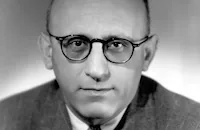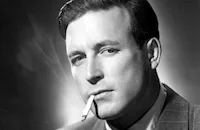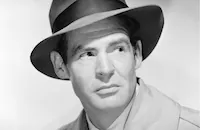Custer of the West
Brief Synopsis
Cast & Crew
Robert Siodmak
Robert Shaw
Mary Ure
Jeffrey Hunter
Ty Hardin
Charles Stalnaker
Film Details
Technical Specs

Synopsis
After a flamboyantly successful career in the Civil War, young Gen. George Armstrong Custer goes West, accompanied by his wife, Elizabeth, to take command of the 7th Cavalry. As he sets out to subdue the Indians, who are rebelling against the government's reservation policies, he overcomes initial conflicts with the hard-drinking Maj. Marcus Reno and with Lieutenant Benteen, who is sympathetic toward the Indians' plight, and tightens discipline among his men. Custer receives a surprise visit from Gen. Philip Sheridan, who orders him to attack a Cheyenne village as appeasement for Washington politicians. Custer complies, but his troops run wild and massacre women and children. Though he refuses to take a conciliatory approach toward Chief Dull Knife, he concludes that government responsiveness to private interests must be curbed if peace is to be secured. A patrol of Custer's men deserts after gold is discovered on the reservation, and he is forced to execute the leader, Sergeant Mulligan; meanwhile, efforts to gain Washington's adherence to the terms of the Indian treaties fail totally. Following an Indian ambush of a new railroad that runs through their land, Custer is called to Washington. He exposes top-level politicians in President Grant's administration who have been bribed to serve as spokesmen for railroad and mining interests, and as a result he is relieved of his command. He is disheartened to hear that his men are about to march against the Indians without him. Through the diplomacy of his wife, however, Custer is permitted to return to Dakota to lead his men in battle. At Little Big Horn, his troops are overwhelmed by the Indians, and Custer is the last to die.

Director

Robert Siodmak
Cast
Robert Shaw

Mary Ure

Jeffrey Hunter

Ty Hardin
Charles Stalnaker
Robert Hall

Lawrence Tierney

Kieron Moore
Marc Lawrence

Robert Ryan
Jack Gaskins
John Clarke
Bill Christmas
Joe Zboran
Jack Cooper
Carl Rapp
Bud Strait
Dennis Kilbane
Jack Taylor
Fred Kohler
Luis Rivera
Clemence Bettany
Barta Barri
John Dillon
John Underhill
Robert Reynolds
Crew
Eva Del Castillo
Louis Dolivet
Jean D' Eaubonne
Bernard Gordon
Julian Halevy
José Manuel M. Herrero
Kurt Herrnfeld
Will Holt
Lillian Kelly
John Kirby
Irving Lerner
Irving Lerner
Eugene Lourie
Antonio Mateos
Julio Molina
José María Ochoa
Cecilio Paniagua
Alejandro Peria
Maurice Rootes
Royal Philharmonic Orchestra
Julian Ruiz
Gregorio Sacristan
Lester A. Sansom
Bernardo Segáll
Bernardo Segáll
Robert Shaw
Charles Simminger
Alban Streeter
Philip Yordan
Laure De Zarate

Film Details
Technical Specs

Articles
Custer of the West
The opening sequences follow the headstrong Custer (Robert Shaw) through various skirmishes as the War Between the States waned. Conscious that no other peacetime assignment would sit well with the restless warrior, General Philip Sheridan (Lawrence Tierney) assigns him command of the Seventh Cavalry, whose outpost faces constant conflict with the Native Americans of the region. (In one of the script's more pronounced breaks with history, it identifies the Cheyenne, rather than the Sioux, as Custer's nemesis.)
Accompanied by his dutiful wife Elizabeth (Mary Ure, Shaw's real-life wife), Custer settles into his new command, and wastes no time alienating his new charges with his dictatorial, off-putting manner. Of his new seconds-in-command, he regards Major Reno (Ty Hardin) as a hopeless alcoholic, and is contemptuous toward Lieutenant Benteen (Jeffrey Hunter) who feels sympathetic towards the Cheyenne. Matters get progressively worse when Sheridan mandates an attack on a Cheyenne village, which disintegrates into open slaughter. Compounding matters, several soldiers desert the outpost to pan for gold, spurring the capture and execution for desertion of the ringleader, Sergeant Mulligan (Robert Ryan, making the most out of the small but showy role.)
In reprisal for the massacre, the angered Cheyenne commence a brutal assault on a passenger train making its initial run through the territory. The appalling casualties result in Custer's recall to Washington as a scapegoat before Congress; in a remarkably politically loaded sequence, Custer blames the deteriorating situation on the government's and military's willingness to kowtow to big business. Relieved of his command, the general becomes mired in disillusionment and despair, until Elizabeth's pleadings and machinations result in the restoration of his commission. His return to the Dakotas, and the miscalculations that lead to his destiny at Little Big Horn, take the movie to a sobering close.
After the original director, Akira Kurosawa, bowed out of the project, Yordan handed the director's reins to Robert Siodmak. The German-born helmer who had been responsible for a raft of film noir staples from The Killers (1946) to Phantom Lady (1944) to Criss Cross (1949) had by the '60s been relegated to turning out unremarkable fare in Europe. His health was in decline, and his work on Custer of the West is perfunctory at best.
As a completed whole, Custer of the West suffers from a reduction of its original scope and concept. Shot with the intent of making the film one of the final releases in Cinerama, the film was almost exclusively exhibited in conventional widescreen. There were no less than three prolonged, point-of-view set pieces in the script--a driverless stagecoach's mountainside descent, a runaway railroad car's trek towards a doomed trestle, and a soldier's attempt to escape a Cheyenne ambush via a log flume--that had their potential thrill-ride impact diminished as a result.
The film's chief virtue is Shaw's intense work in the title role. The characterization is neither the glossy treatment given by Errol Flynn in They Died with Their Boots On (1941), or Richard Mulligan's darkly comic megalomaniac in Arthur Penn's Little Big Man (1970). Shaw gave a textured effort that resulted in a more complex portrait of Custer as soldier and man. Notably, many of the principal performers came to untimely ends. Shaw was only 51 when he succumbed to a heart attack in 1978. The London stage veteran Ure, whose onscreen resume was relatively spare, had died three years earlier at age 42 as a result of an accidental overdose of liquor and tranquilizers. Hunter, whose most noted performance was as Jesus in the Yordan-scripted King of Kings (1961), died in 1969, age 42, as a result of injuries sustained in a domestic fall.
Producer: Irving Lerner, Philip Yordan
Director: Robert Siodmak
Screenplay: Bernard Gordon, Julian Zimet
Cinematography: Cecilio Paniagua
Film Editing: Peter Parasheles, Maurice Rootes
Art Direction: Jean d'Eaubonne, Eugene Lourie, Julio Molina
Music: Bernardo Segall
Cast: Robert Shaw (General George Armstrong Custer), Mary Ure (Elizabeth Custer), Ty Hardin (Maj. Marcus Reno), Jeffrey Hunter (Capt. Benteen), Lawrence Tierney (Gen. Philip Sheridan).
C-143m. Letterboxed.
by Jay S. Steinberg

Custer of the West
Quotes
Trivia
Originally to be directed by Akira Kurosawa, but he pulled out.
While this film was still in production, Philip Yordan and his company (Security Pictures) had production designer and special effects expert Eugene Lourie design and shoot special effects footage for Krakatoa, East of Java (1969) even though there was no script. This footage would also be shot in large format for Cinerama presentation. Those who were shown the early footage began ignoring this film and asking when "Krakatoa" would be ready.
Notes
The working title of this film is Custer. Although Julian Halevy was given co-credit for the screenplay when the film was initially released, according to official WGA records, Halevy was a pseudonym for writer Julian Zimet. The WGA changed the screenplay credit to read: "Screenplay by Bernard Gordon and Julian Zimet." Custer of the West was filmed in Spain and presented in Cinerama for some roadshow engagements. The film was also known as A Good Day for Fighting.

Miscellaneous Notes
Released in United States Winter January 1, 1968
Technirama 70
Released in United States Winter January 1, 1968













